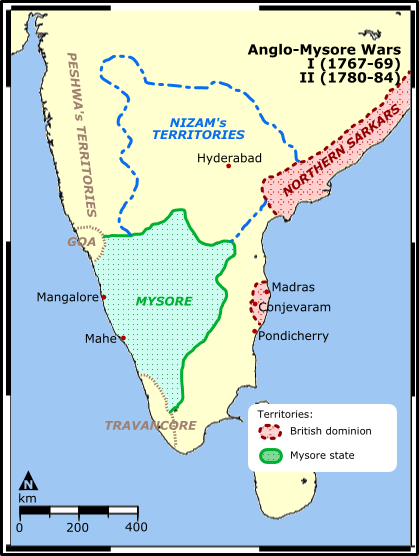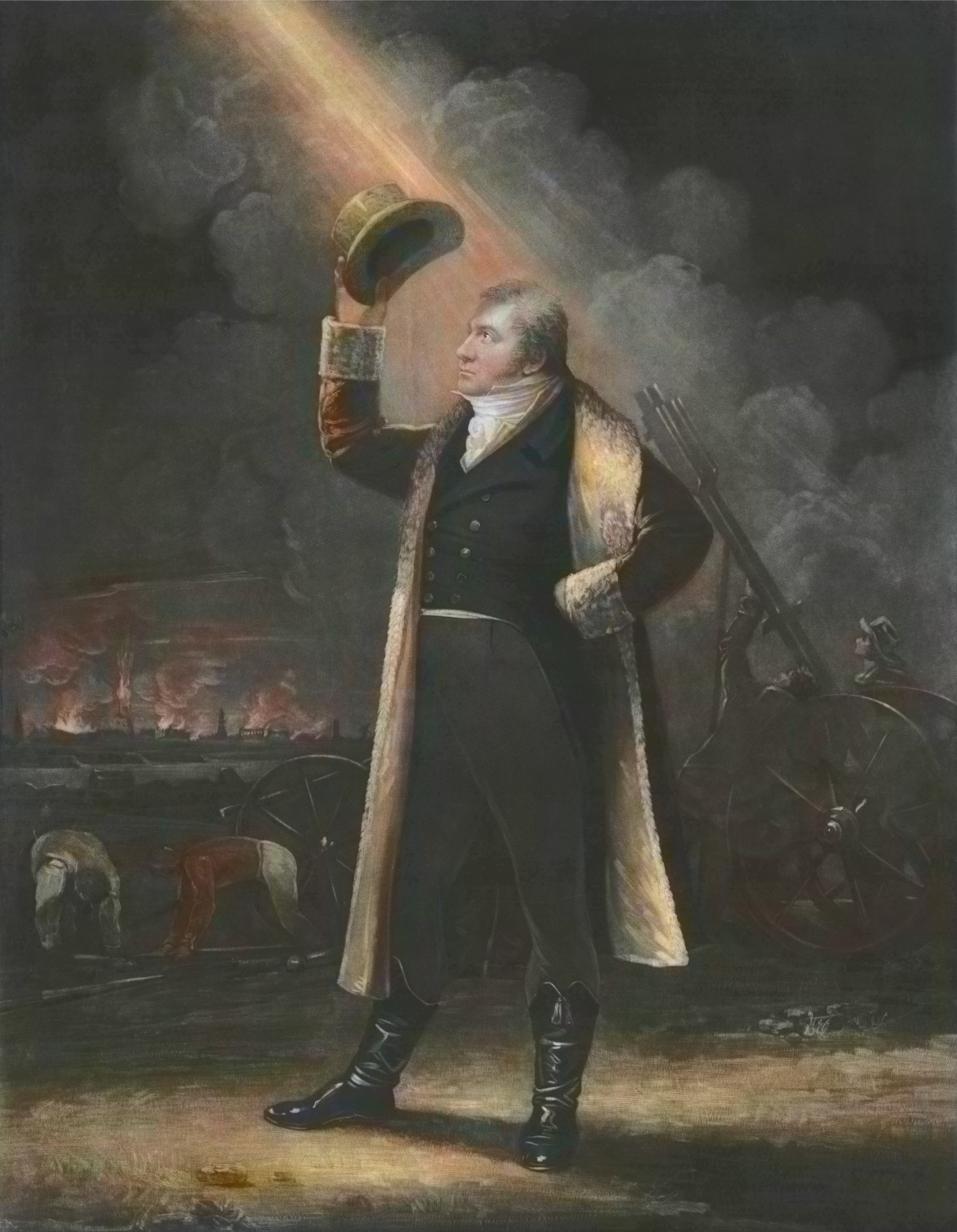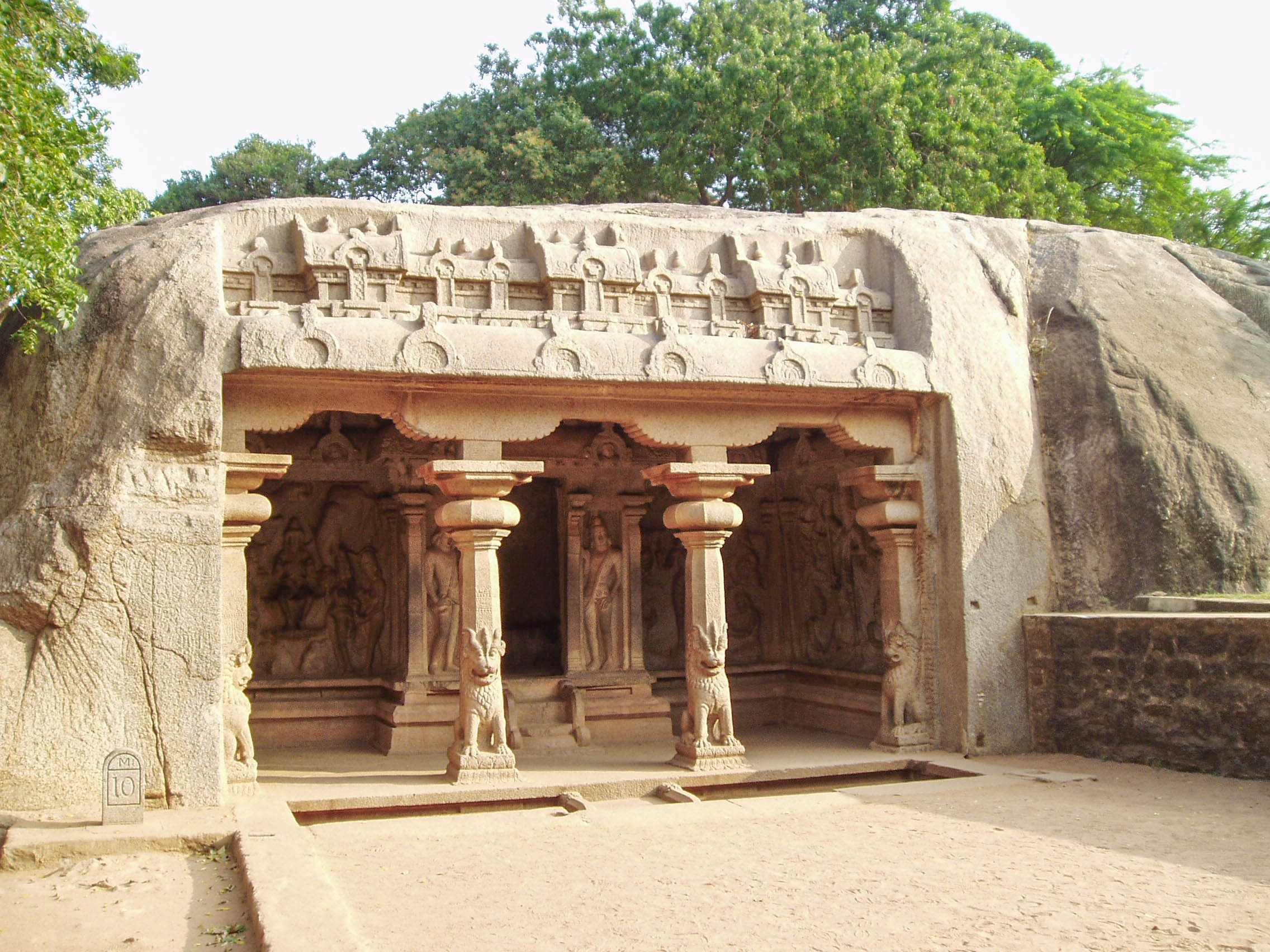|
Battle Of Pollilur (1780)
The Battle of Pollilur (a.k.a. Pullalur), also known as the Battle of Polilore or Battle of Perambakam, took place on 10 September 1780 at Pollilur near Conjeevaram, the city of Kanchipuram in present-day Tamil Nadu state, India, as part of the Second Anglo-Mysore War. It was fought between an army commanded by King Tipu Sultan of the Kingdom of Mysore, and a British East India Company force led by William Baillie. The EIC force suffered a high number of casualties before surrendering. It was fought between a Brigade Column of the East India Company, led by Colonel William Baillie, and the Mysore Army, under the command of Haidar Ali and Tipu Sultan. It was the worst loss the East India Company suffered on the subcontinent until Chillianwala. Benoît de Boigne, a French officer in the service of 6th Regiment of Madras Native Infantry, wrote, "There is not in India an example of a similar defeat". Background King Tipu prevented Baillie from joining another force, consisti ... [...More Info...] [...Related Items...] OR: [Wikipedia] [Google] [Baidu] |
Second Anglo-Mysore War
The Second Anglo-Mysore War was a conflict between the Kingdom of Mysore and the British East India Company from 1780 to 1784. At the time, Mysore was a key French ally in India, and the conflict between Britain against the French and Dutch in the American Revolutionary War influenced Anglo-Mysorean hostilities in India. The great majority of soldiers on the company side were raised, trained, paid and commanded by the company, not the British government. However, the company's operations were also bolstered by Crown troops sent from Great Britain, and by troops from Hanover, which was also ruled by Great Britain's King George III. Following the British seizure of the French port of Mahé in 1779, Mysorean ruler Hyder Ali opened hostilities against the British in 1780, with significant success in early campaigns. As the war progressed, the British recovered some territorial losses. Both France and Britain sent troops and naval squadrons from Europe to assist in the war effort, w ... [...More Info...] [...Related Items...] OR: [Wikipedia] [Google] [Baidu] |
Arcot
Arcot (natively spelt as Ārkāḍu) is a town and urban area of Ranipet district in the Indian state of Tamil Nadu. Located on the southern banks of Palar River, the city straddles a trade route between Chennai and Bangalore or Salem, between the Mysore Ghat and the Javadi Hills (Javvadhu malai). It is a Tri-City with the adjacent municipalities of Walajapet and Ranipet. Etymology ''Arcot'' is the anglicized form of the Tamil word ''ārkāḍ'', which is commonly believed to have been derived from the Tamil words ''aaru'' (River) + ''kaadu'' (forest). However, ''arkaadu'' meant 'a forest of fig trees'. Geography Arcot is located at . It has an average elevation of 164 metres (538 ft). Government Arcot Municipality was constituted in 1959. It had Third Grade Municipality and was subsequently upgraded to second Grade Municipality in 1973. In July 1998, it was upgraded to I Grade Municipality. The selected council with 30 members and chairpersons have functioned ... [...More Info...] [...Related Items...] OR: [Wikipedia] [Google] [Baidu] |
Congreve Rocket
The Congreve rocket was a type of rocket artillery designed by British inventor Sir William Congreve, 2nd Baronet, Sir William Congreve in 1808. The design was based upon Mysorean rockets, the rockets deployed by the Kingdom of Mysore against the East India Company during the Second Anglo-Mysore War, Second, Third Anglo-Mysore War, Third, and Fourth Anglo-Mysore Wars. Lieutenant general Thomas Desaguliers, colonel commandant of the Royal Artillery at Woolwich, was impressed by reports of their effectiveness, and undertook several unsuccessful experiments to produce his own rocket weapons. Several captured Mysorean rockets were sent to Great Britain following the annexation of the Mysorean kingdom into Company rule in India, British India following the death of Tipu Sultan in the Siege of Seringapatam (1799), siege of Seringapatam. The project was continued chiefly with William Congreve, who set up a research and development programme at the Royal Arsenal, Woolwich Arsenal's lab ... [...More Info...] [...Related Items...] OR: [Wikipedia] [Google] [Baidu] |
Fourth Anglo-Mysore War
The Fourth Anglo-Mysore War was a conflict in South India between the Kingdom of Mysore against the British East India Company and the Hyderabad Deccan in 1798–99. This was the last of the four Anglo-Mysore Wars. The British captured the capital of Mysore. The ruler Tipu Sultan was killed in the battle. Britain took indirect control of Mysore, restoring the Wadiyar dynasty to the Mysore throne (with a British commissioner to advise him on all issues). Tipu Sultan's young heir, Fateh Ali, was sent into exile. The Kingdom of Mysore became a princely state in a subsidiary alliance with British India covering parts of present Kerala–Karnataka and ceded Coimbatore, Dakshina Kannada and Uttara Kannada to the British. Background Napoleon Bonaparte's landing in Ottoman Egypt in 1798 was intended to further the capture of the British possessions in India, and the Kingdom of Mysore was a key to that next step, as the ruler of Mysore, Tipu Sultan, sought France as an ally and his lett ... [...More Info...] [...Related Items...] OR: [Wikipedia] [Google] [Baidu] |
Mysorean Rockets
Mysorean rockets were an Indian military weapon. The iron-cased rockets were successfully deployed for military use. They were the first successful iron-cased rockets, developed in the late 18th century in the Kingdom of Mysore (part of present-day India) under the rule of King Hyder Ali. The Mysorean army, under King Hyder Ali and his son King Tipu Sultan, used the rockets effectively against the British East India Company during the 1780s and 1790s. According to James Forbes, Marathas also used iron-encased rockets in their battles. Their conflicts with the company exposed the British to this technology further, which was then used to advance European rocketry with the development of the Congreve rocket in 1805. Technology and deployment There was a regular rocket corps in the Mysore Army, beginning with about 1,200 men in King Hyder Ali's time. During the Second Anglo-Mysore War, Colonel William Baillie's ammunition stores are thought to have been detonated by a stra ... [...More Info...] [...Related Items...] OR: [Wikipedia] [Google] [Baidu] |
Battle Of Pollilur (1781)
The Battle of Pollilur was fought on 27 August 1781, between forces of the Kingdom of Mysore under Hyder Ali and British East India Company The East India Company (EIC) was an English, and later British, joint-stock company that was founded in 1600 and dissolved in 1874. It was formed to Indian Ocean trade, trade in the Indian Ocean region, initially with the East Indies (South A ... forces led by General Eyre Coote. The battle was fought on the site of a 1780 encounter in which a Company force was almost completely routed or captured. In the 1781 battle, the company's army was organized into two lines. One line fought against the troops under Tipu Sultan. But Hyder Ali's army faced severe casualties and retreated to Kanchipuram. After the battle, a shortage of provisions led Coote to move his forces toward Tripassore.Roy p.85 Both the sides retreated in a drawn battle and both claimed victory by firing a salute though the British claimed "dubious victory". Battlefiel ... [...More Info...] [...Related Items...] OR: [Wikipedia] [Google] [Baidu] |
Eyre Coote (East India Company Officer)
Lieutenant-General Sir Eyre Coote, KB ( – 28 April 1783) was a British army officer and politician who represented Leicester and Poole in the House of Commons of Great Britain from 1768 to 1780. He is best known for his many years of service with the Bengal Army in India, where his victory at the Battle of Wandiwash was considered a decisive turning point in the struggle for control over the region between Britain and France. Coote was known by his sepoy troops as Coote Bahadur (Coote the Brave). Early life A member of the Coote family headed by the Earl of Mountrath, he was born in Kilmallock, near Limerick, Ireland, the son of the Reverend Chidley Coote and Jane Evans, daughter of George Evans, and sister of George Evans, 1st Baron Carbery. He entered the 27th Regiment of Foot. He first saw active service in the Jacobite rising of 1745, and later obtained a captaincy in the 39th Regiment, the first regular British regiment to serve in India. Career in India Recap ... [...More Info...] [...Related Items...] OR: [Wikipedia] [Google] [Baidu] |
Battle Of Pollilur
The Battle of Pollilur (a.k.a. Pullalur), also known as the Battle of Polilore or Battle of Perambakam, took place on 10 September 1780 at Pollilur near Conjeevaram, the city of Kanchipuram in present-day Tamil Nadu state, India, as part of the Second Anglo-Mysore War. It was fought between an army commanded by King Tipu Sultan of the Kingdom of Mysore, and a British East India Company force led by William Baillie. The EIC force suffered a high number of casualties before surrendering. It was fought between a Brigade Column of the East India Company, led by Colonel William Baillie, and the Mysore Army, under the command of Haidar Ali and Tipu Sultan. It was the worst loss the East India Company suffered on the subcontinent until Chillianwala. Benoît de Boigne, a French officer in the service of 6th Regiment of Madras Native Infantry, wrote, "There is not in India an example of a similar defeat". Background King Tipu prevented Baillie from joining another force, consisti ... [...More Info...] [...Related Items...] OR: [Wikipedia] [Google] [Baidu] |
Mahendravarman I
Mahendravarman I (600–630 CE) was a Pallava emperor who ruled over realm covering the southern portions of present-day Andhra region and northern regions of what forms present-day Tamil Nadu in India, in the early 7th century. He was a scholar, a painter, an architect and a musician. He was the son of Simhavishnu, who defeated the Kalabhras and re-established the Pallava kingdom. During his reign, the Chalukya monarch Pulakeshin II attacked the Pallava realm. The Pallavas fought a series of wars in the northern Vengi region, before Mahendra-varman decimated his chief enemies at Pullalur (according to Pallava grants at Kuram, Kasakudi and Tadantottam). Although Mahendra-varman saved his capital, he lost the northern provinces to Pulakeshin. Tamil literature flourished under his rule, with the rise in popularity of ''Tevaram'' written by Appar and Sambandhar. Mahendravarman I was the author of the play '' Mattavilasa Prahasana'' which is a Sanskrit satire. During his perio ... [...More Info...] [...Related Items...] OR: [Wikipedia] [Google] [Baidu] |
Pallava Dynasty
The Pallava dynasty existed from 275 CE to 897 CE, ruling a significant portion of the Deccan, also known as Tondaimandalam. The Pallavas played a crucial role in shaping in particular southern Indian history and heritage. The dynasty rose to prominence after the downfall of the Satavahana Empire, whom they had formerly served as feudatories. The Pallavas became a major southern Indian power during the reign of Mahendravarman I (600–630 CE) and Narasimhavarman I (630–668 CE), and dominated the southern Telugu region and the northern parts of the Tamil region for about 600 years, until the end of the 9th century. Throughout their reign, they remained in constant conflict with both the Chalukyas of Vatapi to the north, and the Tamil kingdoms of Chola and Pandyas to their south. The Pallavas were finally defeated by the Chola ruler Aditya I in the 9th century CE. The Pallavas are most noted for their patronage of Hindu Vaishnava temple architecture, the fine ... [...More Info...] [...Related Items...] OR: [Wikipedia] [Google] [Baidu] |
Pulakeshin II
Pulakeshin II (IAST: Pulakeśin r. –642 CE) popularly known as Immaḍi Pulakeśi, was the greatest Chalukyan Emperor who reigned from Vatapi (present-day Badami in Karnataka, India). During his reign, the Chalukya empire expanded to cover most of the Deccan region in peninsular India. A son of the Chalukya monarch Kirttivarman I, Pulakeshin overthrew his uncle Mangalesha to gain control of the throne. He suppressed a rebellion by Appayika and Govinda, and decisively defeated the Kadambas of Banavasi in the south. The Alupas and the Gangas of Talakadu recognized his suzerainty. He consolidated the Chalukya control over the western coast by subjugating the Mauryas of Konkana. His Aihole inscription also credits him with subjugating the Latas, the Malavas, and the Gurjaras in the north. The most notable military achievement of Pulakeshin was his victory over the powerful northern emperor Harshavardhana, whose failure to conquer the Chalukyan territories to the south ... [...More Info...] [...Related Items...] OR: [Wikipedia] [Google] [Baidu] |
Badami Chalukya Empire
The Chalukya dynasty () was a Classical Indian dynasty that ruled large parts of southern and central India between the 6th and the 12th centuries. During this period, they ruled as three related yet individual dynasties. The earliest dynasty, known as the "Badami Chalukyas", ruled from Vatapi (modern Badami) from the middle of the 6th century. The Badami Chalukyas began to assert their independence at the decline of the Kadamba kingdom of Banavasi and rapidly rose to prominence during the reign of Pulakeshin II. After the death of Pulakeshin II, the Eastern Chalukyas became an independent kingdom in the eastern Deccan. They ruled from Vengi until about the 11th century. In the western Deccan, the rise of the Rashtrakutas in the middle of the 8th century eclipsed the Chalukyas of Badami before being revived by their descendants, the Western Chalukyas, in the late 10th century. These Western Chalukyas ruled from Kalyani (modern Basavakalyan) until the end of the 12th ... [...More Info...] [...Related Items...] OR: [Wikipedia] [Google] [Baidu] |








